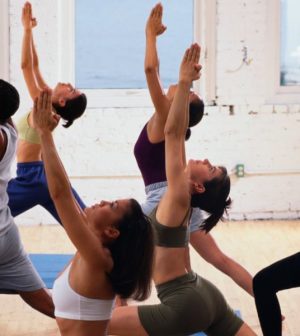- Navigating Your Midlife Crisis: Embracing New Possibilities
- City Raccoons Showing Signs of Domestication
- Mapping the Exposome: Science Broadens Focus to Environmental Disease Triggers
- One Week Less on Social Media Linked to Better Mental Health
- Your Brain Changes in Stages as You Age, Study Finds
- Some Suicide Victims Show No Typical Warning Signs, Study Finds
- ByHeart Formula Faces Lawsuits After Babies Sickened With Botulism
- Switch to Vegan Diet Could Cut Your Greenhouse Gas Emissions in Half
- Regular Bedtime Does Wonders for Blood Pressure
- Dining Alone Could Mean Worse Nutrition for Seniors
Use ‘Proper Form’ When Practicing Yoga

Yoga can make you flexible and strong, but it can also hurt you if not practiced correctly, an orthopedic expert warns.
Improper technique can lead to serious muscle damage, including strain and overstretching of the neck, shoulders, spine, legs and knees, according to Dr. Brett Freedman. He is an orthopedic spine and trauma surgeon, and an American Academy of Orthopaedic Surgeons (AAOS) spokesperson.
“The key to a successful yoga workout is using proper form,” he said in an AAOS news release. “When the technique of yoga is compromised, the body is placed at an increased risk of injury. New participants should work with a qualified instructor until they are confident in their practice.”
In 2016, nearly 24,000 people in the United States were treated for yoga-related injuries, according to the Consumer Product Safety Commission.
The AAOS outlined a number of safety tips to reduce the risk of yoga-related injuries.
- People with any medical conditions or injuries should talk to their doctor before doing yoga, and should inform their yoga instructor so that he or she can recommend pose modifications.
- There are hundreds of different types of yoga and some are more strenuous than others. Learn which type of yoga would best suit you. It’s also important to select an appropriate class level. Beginners should start slowly and learn breathing and other basics first.
- Wear clothing that permits proper movement, and warm up thoroughly before a yoga session.
- Don’t try positions that exceed your experience or comfort level. If you’re unsure about a pose or movement, ask your instructor.
- Drink plenty of fluids, especially if you’re doing hot yoga.
- If you experience pain or exhaustion during yoga, stop or take a break. Persistent pain should be checked by a doctor.
More information
The U.S. National Center for Complementary and Integrative Health has more on yoga.
Source: HealthDay
Copyright © 2025 HealthDay. All rights reserved.










